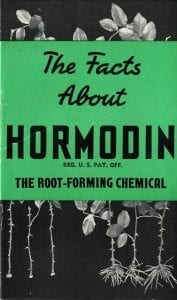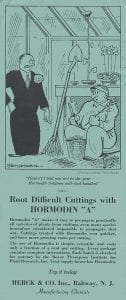News
Going Back to BTI’s Roots: A History of Hormodin
 Home gardeners and commercial growers may not be aware that a commonly used rooting powder that accelerates root growth on plant cuttings was first discovered at the Boyce Thompson Institute (BTI) in the 1930’s.
Home gardeners and commercial growers may not be aware that a commonly used rooting powder that accelerates root growth on plant cuttings was first discovered at the Boyce Thompson Institute (BTI) in the 1930’s.
The rooting compound, originally trademarked as Hormodin, was one of many chemicals tested in the labs of Percy Zimmerman and Alfred Hitchcock at BTI’s original location in Yonkers, New York. They reported their findings in a 1935 paper. Also known by its chemical name, Indole-3-butyric Acid (IBA), Hormodin works by mimicking a plant hormone called auxin that regulates many aspects of plant growth. The institute patented the discovery and licensed it to Merck & Co. for production.
“As a result of an exhaustive investigation of the effects of various types of growth substances on plants, we have discovered that certain organic compounds exercise a pronounced stimulating effect on root-growth, and are highly valuable in promoting and inducing root-growth on plant slips or cuttings,” stated Zimmerman and Hitchcock in the patent application.
Plant scientists in the 1930s experimented with all manner of chemicals to see which compounds would stimulate growth, cause roots to sprout and increase the lifespan of cut flowers. By finding the ones that impact plants, they could gain a better understanding of plant development and perhaps identify products that would benefit farmers and commercial growers. Later on, the same researchers also discovered the herbicidal effects of one of the first pesticides, 2,4-D. Researchers tried out compounds ranging from aspirin to alcohol and nicotine, and tested hormone-like compounds extracted from microorganisms, corn oil, wood and even urine.
Zimmerman and Hitchcock also investigated the effects of illuminating gas on greenhouse plants. The gas also caused rooting, but was not useful for greenhouse propagation because it diffused through the plant and triggered rooting in inconvenient places. What the researchers wanted was a stable compound that would only cause rooting at the location where it was applied.

Percy Zimmerman and Alfred Hitchcock each gave more than 30 years of service to the institute, researching plant hormones, herbicides and air pollution. They were nicknamed “Zim” and “Hicky” in the lab.
Through trial and error, Zimmerman and colleagues identified several compounds that mimicked the plant hormone auxin. They didn’t discover auxin itself—that was isolated by a group of chemists in 1934 and identified it as indoleacetic acid (IAA). Later, in 1937, Kenneth Thimann at Harvard University synthesized IAA and showed that it worked as well as the natural plant hormone at stimulating growth.
The BTI researchers received compounds to test out from the Canadian chemist R.H. Manske of the National Research Council in Ottawa. One of these happened to be IBA, which they found to be effective at triggering root growth in all kinds of plants.
In 1935, Hitchcock and Zimmerman won the AAAS Newcomb Cleveland Prize for their paper, “The Initiation and Growth of Secondary Roots Induced by Growth Substances,” read before the Botanical Society of America.
 Merck & Co. trademarked IBA as Hormodin, and widely advertised the product. One ad from Merck & Co. even boasted that BTI double checked each lot of Hormodin, to ensure “a definite amount of root-inducing potency in every package.”
Merck & Co. trademarked IBA as Hormodin, and widely advertised the product. One ad from Merck & Co. even boasted that BTI double checked each lot of Hormodin, to ensure “a definite amount of root-inducing potency in every package.”
The research and the resulting product generated a fair amount of interest from the public as well. A 1937 Better Homes and Gardens story said that using “Hormodin isn’t any more difficult than playing with the chemistry set you bought Junior” and that the compounds would make nature “hurry up, [and] jump thru hoops” or even to “make a raincoat out of the rubber plant in your living room.”
Zimmerman’s work on a similar compound, B-naphthoxyacetic acid, was even mentioned in a 1941 issue of Popular Science. By releasing the compound into a greenhouse, he could cause tomato flowers to form seedless tomatoes and induce tubular flowers that wouldn’t open.
The patent is now expired, but IBA is still sold as Hormodin and as the active ingredient in multiple gardening products. The BTI greenhouse even has an old box of Hormodin in the back its storage closet.
Besides being useful for propagating plant cuttings, these hormones, and the compounds that mimic them, have additional uses for research. Assistant Professor Joyce Van Eck uses them in her tissue cultures on especially stubborn specimens.
“For plant species that we have a difficult time getting to root in culture, we’ll try IBA,” said Van Eck. “We use IBA and IAA and all these other auxins in culture but we never think about how they were discovered.”
So the next time you’re using a rooting powder to give your plant cuttings a jumpstart, think of Zimmerman and Hitchcock, whose trials and errors yielded insights into the effects of plant hormones, as well as a highly useful garden product.


